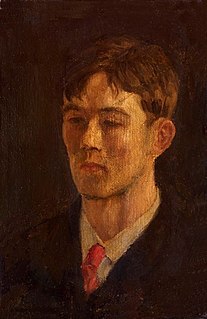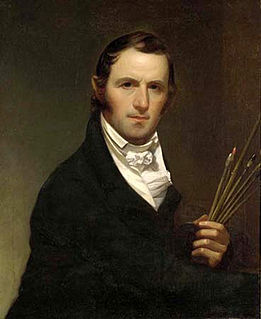
Winterthur Museum, Garden and Library is an American estate and museum in Winterthur, Delaware. Pronounced “winter-tour," Winterthur houses one of the richest collections of Americana in the United States. The museum and estate were the home of Henry Francis du Pont (1880–1969), Winterthur's founder and a prominent antiques collector and horticulturist.

The Pennsylvania Academy of the Fine Arts (PAFA) is a museum and private art school in Philadelphia, Pennsylvania. It was founded in 1805 and is the first and oldest art museum and art school in the United States. The academy's museum is internationally known for its collections of 19th- and 20th-century American paintings, sculptures, and works on paper. Its archives house important materials for the study of American art history, museums, and art training. It offers a Bachelor of Fine Arts, Master of Fine Arts, certificate programs, and continuing education.

Robert Feke was an American portrait painter born in Oyster Bay, Long Island, New York. According to art historian Richard Saunders, "Feke’s impact on the development of Colonial painting was substantial, and his pictures set a new standard by which the work of the next generation of aspiring Colonial artists was judged." In total, about 60 paintings by Feke survive, twelve of which are signed and dated.

Henry Francis du Pont was an American horticulturist, collector of early American furniture and decorative arts, breeder of Holstein Friesian cattle, and scion of the powerful du Pont family. Converted into a museum in 1951, his estate of Winterthur in Delaware is the world's premier museum of American furniture and decorative arts.

Walter Emerson Baum was an American artist and educator active in the Bucks and Lehigh County areas of Pennsylvania in the United States. In addition to being a prolific painter, Baum was also responsible for the founding of the Baum School of Art and the Allentown Art Museum.

Laura Wheeler Waring was an American artist and educator, best known for her paintings of prominent African Americans that she made during the Harlem Renaissance. She taught art for more than 30 years at Cheyney University in Pennsylvania.
Karl Zerbe was a German-born American painter and educator.

Thomas Pollock Anshutz was an American painter and teacher. Known for his portraiture and genre scenes, Anshutz was a co-founder of The Darby School. One of Thomas Eakins's most prominent students, he succeeded Eakins as director of drawing and painting classes at the Pennsylvania Academy of Fine Arts.
William T. Williams is an American painter and educator. He is known for his process-based approach to painting that engages motifs drawn from personal memory and cultural narrative to create non-referential, abstract compositions. He was a Professor of Art at Brooklyn College, City University of New York from 1971 to 2008.
Clara Elsene Peck was an American illustrator and painter known for her illustrations of women and children in the early 20th century. Peck received her arts education from the Minneapolis School of Fine Arts and was employed as a magazine illustrator from 1906 to 1940. Peck's body of work encompasses a wide range, from popular women's magazines and children's books, works of fiction, commercial art for products like Ivory soap, and comic books and watercolor painting later in her career. Peck worked during the "Golden Age of American Illustration" (1880s–1930s) contemporaneous with noted female illustrators Jessie Willcox Smith, Elizabeth Shippen Green and Violet Oakley.

Jacob Eichholtz (1776–1842) was an early American painter, known primarily for his portraits in the Romantic Victorian tradition. Born in Lancaster, Pennsylvania in a family of prosperous Pennsylvania Germans, he spent most of his professional life in Philadelphia. A coppersmith by trade, he turned to painting and achieved both recognition and success despite being mainly self-taught as an artist. He is known to have painted over 800 portraits over the course of 35 years. Hundreds of his works are housed in art museums, historical societies, and private collections throughout the United States.

Rubens Peale was an American museum administrator and artist. Born in Philadelphia, he was the son of artist-naturalist Charles Willson Peale. Due to his weak eyesight, he did not practice painting seriously until the last decade of his life, when he painted still life.
Francis de Erdely (1904–1959) was a Hungarian-American artist who was renowned in Europe and the United States for his powerful figure paintings and drawings as well as for his teaching abilities.
David Frost Sellin was an American art historian, curator, educator, and author. He taught at a number of universities, worked on the staffs of several museums, and served as curator of the U.S. Capitol, 1976-1980.

Elizabeth Wentworth Roberts was an American painter who lived and worked in Philadelphia, Pennsylvania, Paris, and Concord, Massachusetts. She established the Jennie Sesnan Gold Medal at the Pennsylvania Academy of the Fine Arts, where she had studied and won the Mary Smith Prize. She also studied in Paris at Académie Julian and Florence. In Massachusetts, Roberts founded and funded the Concord Art Association.
Constance Coleman Richardson (1905–2002) was an American painter best known for her American Scene landscapes and interplay of light on figures, evocative of Edward Hopper. She attended Vassar College and Pennsylvania Academy of the Fine Arts and was married to art historian and museum director Edgar Preston Richardson from 1931 until his death in 1985.
The James Smithson Medal, established in 1965, is awarded to those who have made "exceptional contributions to art, science, history, education and technology." It is presented by the Smithsonian Institution which states that it is the organization's "most prestigious and highest award."

Harriet Christina Cany Peale (1799–1869) was an American landscape, portrait, and genre painter of the mid-nineteenth century. Although sometimes described as a copyist, a greater share of her oeuvre has been made public in recent years, allowing Cany Peale to earn recognition for her genre and landscape paintings. She has been located in contemporary scholarship as an artist of the Hudson River School.
Sidney Goodman was an American figurative painter and draftsman from Philadelphia, PA who explored the human form. Goodman received public notice in the early 1960s for his oil paintings, leading to his inclusion in the 1973 Whitney Biennial. In 1996, the Philadelphia Museum of Art presented a retrospective show of Goodman's paintings and drawings.

Captain John Purves and His Wife, Eliza Anne Pritchard, is an oil-on-canvas portrait created by American painter Henry Benbridge (1743–1812). It was painted in Charleston, South Carolina, in 1775. A bequest from Henry Francis du Pont, the painting is held in the permanent collection of the Winterthur Museum, Garden and Library.












